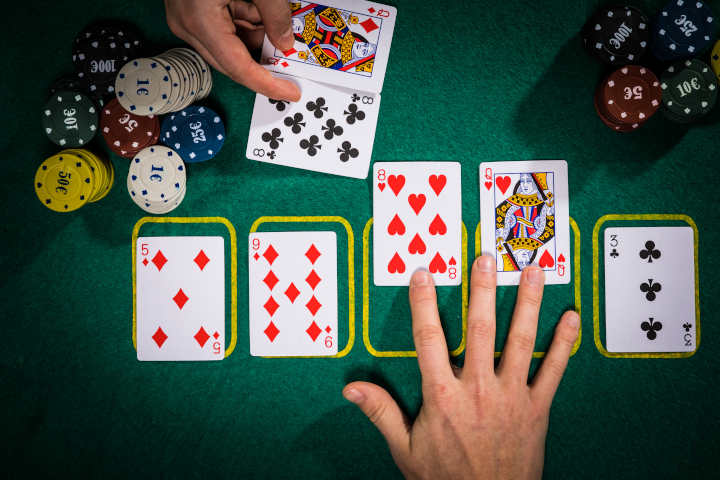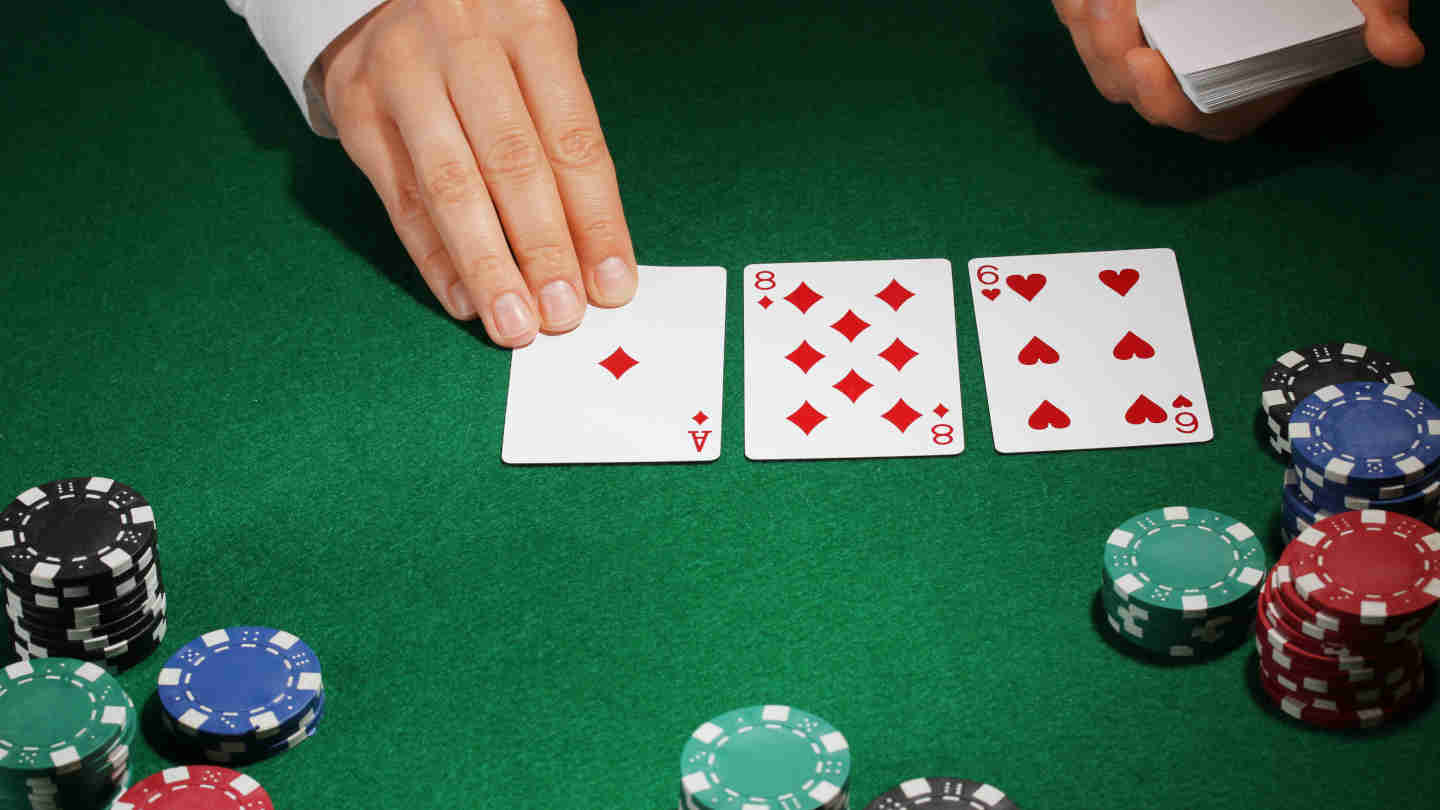Counting Outs in Poker – It’s Easier than You Think

10 minutes
Poker is a complex game with many variables, and to be a winner, you are going to need many different skills and abilities.
While some poker players prefer to rely on their instincts and intuition to win at poker, there are some basic mathematical concepts that you will need to learn before you can play the game at a high level.
Among the very first things to learn is how to count outs in poker. This is an essential step in calculating your odds, making correct calls and folds, and deciding which hands to bluff with.
I am going to teach you how to count outs in poker, how to calculate your odds based on the number of outs you have, and how to disregard certain “dirty” outs in some spots.If you are new to the game, counting outs may be a skill you don’t yet possess, but it is one you will definitely need if you hope to have any success at the tables.
I will also cover the concept of blockers and other useful related ideas such as implied odds and the main reasons why your outs matter so much.
What Are Outs?
The first thing we need to clear up is what the concept of outs means in the first place. If you are new in the poker world, you may not be aware of what outs are, so let’s explain.
Outs are all cards that will help improve your hand from its current status on the flop or turn into a better hand on the turn or river.
A good example to explain outs is when you hold two spades in your hand and the flop comes down with two spades.
In this scenario, you will want to see another spade on the board to make a flush, so you will be hoping that the turn card will be a spade.
Similar scenarios come in other poker situations, such as when you have four cards to a straight or are holding one pair and hoping to improve to three of a kind or two pair.
In every case, an out is a card that helps your hand get better and is likely to make your hand better than the one held by your opponent.
Counting Outs in Poker: Quick Guide

Counting outs in poker is a relatively simple practice. To count outs, you will need to understand the poker hand rankings and be able to recognize in what way your cards connect with the board.
It is also essential to know that there is a total of 52 cards in a deck, four of each ranking and 13 rankings in total.
Based on this information, it will be easy to count the number of outs you have in a poker hand by simply counting out the cards that help your hand.
In the example I gave earlier, where you have two spades, and there are two spades on the board, you have nine outs.
This is because there are 13 spades in total, and you already see four of them on the board. This means nine more are left somewhere in the deck.
The same counting technique can be used when you have any other drawing hand, such as an open-ended straight draw or one pair on the board.
In these cases, you will count the cards that make your straight on either side (normally eight cards) or cards that improve your pair to trips or two pair (normally five cards).
To make things even simpler, here is a quick chart with the pre-calculated number of outs for the most common drawing situations on the flop:
- Open-ended straight flush draw: 15 Outs
- Flush draw with two overcards: 15 Outs
- Gutshot straight flush draw: 12 Outs
- Flush draw: 9 Outs
- Open-ended straight draw: 8 Outs
- Set: 7 Outs
- One pair on the board: 5 Outs
- Gutshot straight draw: 4 Outs
- One pair in hand: 2 outs
These numbers represent the number of cards that will help your hand if you are counting on the flop. Additional turn cards may help your hand and allow you to make a big hand on even more cards.
For instance, when holding a set on the turn, you will get additional full-house outs. The cards that hit the turn could also hit the river to make your hand into a full house.
These numbers are also just absolutes, and there are situations in which you will not want to see certain cards, which I will discuss later on in the section on “dirty outs.”
Calculating Equity Based On Outs
You now know how counting outs in poker is done, but this may not seem like a very useful skill/ Simply knowing how many cards help your hand doesn’t really do too much to help you win a hand.
However, this is not quite true. Knowing how many outs you have is the only way to know how much of a shot you have at one of your cards actually coming on the turn or river.
This number, called equity, is calculated as a percentage and is directly associated with the number of outs you have counted in the previous step.

The logic here is quite simple. We know how many cards are in a deck, and we know how many we have seen already (five by the flop).
Now that we are done counting our outs, we can easily calculate the chances of hitting our hand.
For example, let us assume we are holding Ks Qs on a flop that reads Js Ts 5d. We currently have just king-high but hold the coveted open-ended straight flush draw.
In this scenario, counting outs tells us that we have 15 cards that will help our hand. Any spade, nine, or ace will improve our hand to either a flush or a straight.
We can also improve if a king or a queen comes, but these cards won’t always give us the winner.
For the time being, let us just consider the cards that give us the clear winner in the hand. There are nine spades left in the deck, along with three non-spade nines and three non-spade aces, for a total of 15 outs.
Since we see the two cards in our hand and the three cards on the flop, we can count that there are 47 cards left in the deck.
This means that there are 15 out of 47 cards that help our cause and 32 cards that do not. We should also take into consideration that there are two cards to come, the turn and the river.
The actual math of calculating how often your cards are going to hit is a bit complex. Fortunately, there is a very simple way to go from counting outs to calculating your equity, and this is called the rule of 4 and 2.
Rule of 4 and 2 to Calculate Odds
The rule of 4 and 2 is the simplest possible way to calculate your odds in a hand where you are drawing against your opponent’s hand.
The first thing you will need to apply this technique is to count your outs precisely. Once you are done counting outs, you will do some very simple math and come up with your approximate odds to hit.
If you are on the flop, multiplying the number of your outs by 4 will give you the approximate odds, while you will need to multiply by 2 if the turn has already been dealt out.
For example, if you are drawing to a flush and have nine outs, multiplying by 4 will produce odds of 36%, while the actual equity you have is 35%.
Multiplying by 2 will produce 18%, and your actual odds will be 19.6%. Overall, you will have a quick and satisfactory solution.
The rule of 4 and 2 starts to deviate more significantly from the actual number as your count number gets higher, so make sure to take this into consideration.
For instance, applying the rule of 4 on the flop when you have 20 outs will give you odds of 80%, while your actual odds are only 67.5%.
This is because there will be more situations in which you hit on the turn, denying your odds to improve on the river.
In either case, the rule of 4 and 2 will give you the right number for the vast percentage of cases, and if this does not satisfy you, you can also learn the table below by heart.
This table tells you the exact odds to hit with any number of odds whether you have two or one cards left to see.
| Number of Outs | Odds from Flop to River | Odds from Turn to River |
| 20 | 67.5% | 43.5% |
| 19 | 65% | 41.3% |
| 18 | 62.4% | 39.1% |
| 17 | 59.8% | 37% |
| 16 | 57% | 34.8% |
| 15 | 54.1% | 32.6% |
| 14 | 51.2% | 30.4% |
| 13 | 48.1% | 28.3% |
| 12 | 45% | 26.1% |
| 11 | 41.7% | 23.9% |
| 10 | 38.4% | 21.7% |
| 9 | 35% | 19.6% |
| 8 | 31.5% | 17.4% |
| 7 | 27.8% | 15.2% |
| 6 | 24.1% | 13% |
| 5 | 20.3% | 10.9% |
| 4 | 16.5% | 8.7% |
| 3 | 12.5% | 6.5% |
| 2 | 8.4% | 4.3% |
| 1 | 4.3% | 2.2% |
Counting Outs in Poker in Real Time
Now that you know how to count outs in poker and how to come up with your odds to improve in a hand based on these outs, let’s talk briefly about how you can use this in-game.
Once you have calculated the odds to hit your big poker hand, you will be able to decide whether making a call is worth your money or not using a concept known as pot odds, which I covered more in another guide.
Once you understand pot odds, as well as implied odds and reverse implied odds, you will be able to define your strategy in a hand based on concrete mathematical concepts rather than hunches and guesses.
You will still need to “put your opponent on a hand,” but you will be doing this by defining a whole range of hands they might have, rather than trying to guess the exact hand they have.
These concepts will round out your poker game and give you a huge edge when playing in soft games against weak opponents who don’t know how to do these things.
Dirty Outs and Blockers
I have covered counting outs in poker and calculating your odds, but let’s go a step further and talk about two more advanced concepts that are often neglected by poker players.

The first one is “dirty outs.” Dirty outs are cards that seem like they improve your hand but might actually harm you depending on your opponents’ holdings.
A good example of dirty outs is a hand in which you hold a straight draw, but there are two cards of the same suit on the board.
Let’s assume you are holding Js Ts, and the flop comes 9c 8c 4d. On the face of things, you have eight outs. However, both the Qc and 7c give you a straight but also make a flush possible.
What’s more, they open up the possibility of a four-card flush appearing on the board.
In situations like these, you should tread carefully and not count the dirty outs in full. In fact, in many cases, it is best to avoid chasing draws with many dirty outs, as they tend to get you into more troublesome than good situations.
You will still want to chase your draw if you are getting an extremely good price. However, it is important not to call big bets in spots where your outs could be working against you.
The other concept I want to touch on is one of “blockers.” Blockers are cards that make it less likely that your opponent is holding a certain hand, which gives you options to bluff.
A good example of blockers is holding 7s 7c on a 9h 8h 6d board. If your opponent is showing aggression, it is likely that they have a hand like a draw or two pair rather than a straight. You are holding two of the four sevens they would need to have a straight.
Blockers can be especially useful in games like Pot Limit Omaha, where nutted hands are more frequent, and representing a monster hand is more credible since you are holding four cards in total.
Final Words on Counting Outs in Poker
This small exercise in counting outs may seem trivial to novice players. However, I can promise you that learning how to count outs in Texas Hold’em will change your game from the inside out.
Being able to predict how likely you are to improve is critical in this game, and playing any other way will cost you both money and nerves.
I highly recommend spending the little time that’s needed to learn how to count outs, or at least remembering the most frequent situations and the odds you have in them.
Remember to use the rule of 4 and 2 when calculating your odds, and you will be halfway to becoming a good poker player with a real poker strategy.
- Poker Squeeze Play – Which Hands Make the Most Sense for Squeezing? - August 10, 2023
- How to Play Low Pocket Pairs in Texas Hold’em - July 29, 2023
- How to Make Deep Runs in MTTs More Often - July 22, 2023















